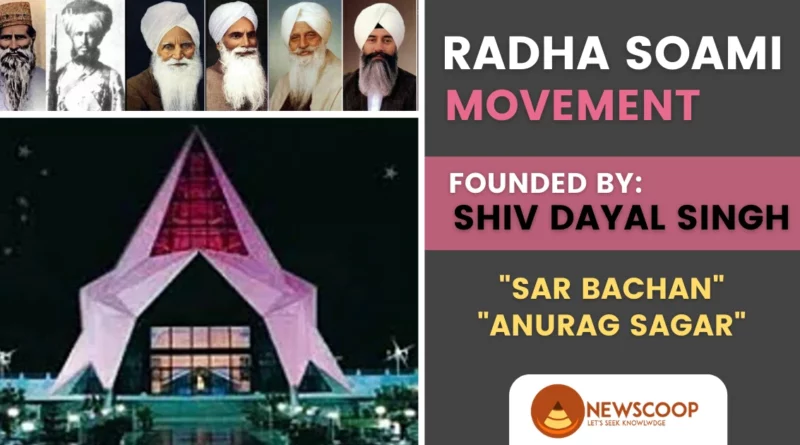Radha Soami Movement
The Radhaswami tradition, also called the Radha Soami Movement, is a spiritual movement that has its roots in the teachings of Seth Shiv Dayal Singh Ji. He was born on 25th August 1818 in the city of Agra, located in northern India. Shiv Dayal Singh’s parents were devout followers of Guru Nanak Dev Ji of Sikhism and a spiritual guru Tulsi Saheb from Hathras.
Further, the Radha Soami Movement is a spiritual tradition that originated in India in the 19th century. It is a devotional movement that emphasizes the importance of love and devotion to God, and the attainment of inner peace through spiritual practices. The Radha Soami movement is also known as Radha Soami Satsang, and it is based on the teachings of a succession of spiritual Masters.
| Name of movement | Radha Soami Movement |
| Founder | Shiv Dayal Singh |
| Founding Year | 1861 |
| Meaning | Master of Energy |
| Key Texts | “Sar Bachan” and “Anurag Sagar” |
| Headquarters | Beas, Punjab, India |
| Current Leader | Gurinder Singh Dhillon |
Background of the Radha Somai Movement
Upon completing his education, Shiv Dayal Saheb worked as a Persian language translator but eventually left the role to join his father’s moneylending business. He began dedicating his time to religious pursuits and was influenced by the teachings of Tulsi Saheb, who emphasized Surat Shabd Yoga, Guru bhakti, and high moral living, which included following a strict Lacto-vegetarian diet.
These teachings were related to various forms of 18th and 19th-century esoteric mysticism that were prevalent in northern India at the time.
Following the death of Sant Tulsi Saheb in 1843, Shiv Dayal Singh devoted himself to the practice of Surat Shabd Yoga for 17 years. In 1861, he began publicly giving discourses based on the scriptures of Sikhism and the writings of Tulsi Saheb of Hathras, which led to the foundation of the Radha Soami movement.
In 1861, Shiv Dayal Singh announced himself as the Sant Satguru, the true teacher of spirituality, and began teaching a group of followers. He started holding public Satsangs or spiritual discourses during the spring festival of Basant Panchami and continued to do so for 17 years.
After his death, his poetic compositions and sayings from Satsang were compiled into two books called “Sar Bachan,” which means “conclusive utterances.” The books were published in two forms:
- Sar Vachan Varik (Sar Bachan in prose)
- Sar Vachan Chhand Band (Sar Bachan in verse).
Some sub-traditions suggest that the Radha Soami movement derived its name from the phrase “Radha Soami,” which means “Lord of the Soul.” Shiv Dayal Singh was considered the “Living Guru” and the embodiment of God by his followers.
Shiv Dayal Singh, the founder of the Radha Soami movement, did not use the term ‘Radhasoami’ himself. In his writings, ‘Sar Bachan,’ he used the term “Sat Nam” to refer to the Supreme Being rather than Radhasoami. Additionally, he initially referred to the Supreme Being by the names “Sat Nam” or True Name, and “Anami” or Nameless.
After the death of Shiv Dayal Saheb, his disciple Salig Ram, and his followers continued to practice the Radha Soami Movement. The term ‘Radha Soami’ was introduced after Salig Ram became a disciple. According to Salig Ram, the term “Radha Soami” means “master of energy” and is derived from the Vaishnava interpretation of “Radha” as the power of the energy of God.
While the gurus and the tradition that followed Shiv Dayal Saheb did not use the term ‘Radhasoami’ during his lifetime, they began using it during initiation rites, meditation practices, and mutual gatherings after his death. This eventually led to the fellowship becoming commonly known as Radha Soami.
Beliefs & Practices of the Radha Soami Movement
The Radhasoami Movement is a spiritual tradition that focuses on the attainment of the divine through the practice of Surat Shabd Yoga. Here are some of the beliefs and practices of the Radhasoami Movement:
- Surat Shabd Yoga: Radhasoami followers believe in the practice of Surat Shabd Yoga, which involves the inner awakening of the soul through the sound current or Shabd. According to their teachings, the ultimate goal is to merge the individual soul with the universal soul through the experience of divine sound.
- Devotion to the Guru: The Radhasoami Movement places great emphasis on devotion to the guru. The guru is considered to be the spiritual guide who can help the followers on the path toward spiritual liberation.
- Vegetarianism: The Radhasoami Movement promotes vegetarianism as a way of maintaining purity and elevating one’s consciousness. They believe that a vegetarian diet helps in the purification of the mind, body, and soul.
- Meditation: Meditation is an essential practice in the Radhasoami tradition. Through the practice of meditation, the followers focus their minds on the inner sound and attempt to connect with the divine.
- Reincarnation: The Radhasoami Movement believes in the cycle of reincarnation. They believe that the soul goes through several lifetimes until it achieves liberation and merges with the divine.
- Karma: Karma is an important aspect of the Radhasoami belief system. They believe that one’s present life is influenced by the actions of past lives and that the present actions will determine future life.
- Social Service: The Radhasoami Movement encourages its followers to engage in social service and to help those in need. They believe that service to humanity is an integral part of spiritual practice.
Successors & Branches
| Successor | Name of Center | Location |
|---|---|---|
| Narayan Devi (“Radhaji”) | Radha Bagh | Agra, India |
| Partap Singh | Dayal Bagh | Agra, India |
| Sanmukh Das | Soamibagh | Agra, India |
| Baba Jaimal Singh | Dera Baba Jaimal Singh | Beas, India |
| Gharib Das | Radha Swami Satsang | Delhi, India |
| Rai Salig Ram | Radha Swami Satsang | Dinapore, India |
Over time, the Radhasoami movement splintered into different branches, each with its own leader and unique practices. Some of the prominent branches of the Radhasoami movement include:
- Radhasoami Satsang, Dayalbagh: This branch of the Radhasoami movement was founded by Rai Saligram’s disciple, Huzur Maharaj (Seth Shiv Dayal Singh). The followers of this branch believe that Huzur Maharaj is the current living guru and the embodiment of God.
- Radhasoami Satsang Sabha, Beas: This branch of the Radhasoami movement was founded by Baba Jaimal Singh in 1891. His disciple, Baba Sawan Singh, succeeded him as the head of the Beas branch. The followers of this branch believe that their guru is the true representative of Radhasoami and consider his teachings to be the ultimate path to salvation.
- Radha Soami Satsang, Dinod: This branch of the Radhasoami movement was founded by Brijmohan Lal Ji in 1861. The followers of this branch believe that the soul can attain salvation only through the grace of the living guru.
- Radhasoami Satsang Sabha, Soami Bagh: This branch of the Radhasoami movement was founded by Shiv Brat Lal in 1901. The followers of this branch believe that the ultimate goal of human life is to attain union with the divine through meditation on the inner sound.
- Dayalbagh Educational Institute: This is an educational institution that was founded by the followers of the Dayalbagh branch of the Radhasoami movement. The institute provides education in various fields, including science, engineering, management, and humanities.
Each of these branches has its own set of practices, rituals, and beliefs, but they all share a common goal of achieving union with the divine through meditation and devotion to the living guru.
Conclusion
The Radha Soami Movement has a rich history and a diverse community of followers with a focus on spirituality, self-realization, and service. The movement was founded by Shiv Dayal Singh in the mid-19th century, and after his death, his disciples continued to spread his teachings and establish their own distinct centers.
Today, there are various branches of the Radha Soami Movement with millions of followers worldwide. The movement continues to emphasize the importance of meditation, service to others, and devotion to the “Supreme Being.” Its teachings have had a significant impact on the spiritual and social fabric of many communities, and its legacy continues to inspire seekers of truth and inner peace.
Thank You!
Who founded the Radha Soami movement?
The Radha Soami movement was founded by Shiv Dayal Singh in the mid-19th century.
What is the significance of the book “Sar Bachan” in the Radha Soami movement?
“Sar Bachan” is a collection of poetic compositions and sayings from Satsang by Shiv Dayal Singh, which were later published in two books. These books are considered the most important scriptures of the Radha Soami movement.
Who were the successors of Shiv Dayal Singh in the Radha Soami movement?
After the death of Shiv Dayal Singh, several of his disciples became successors, including his wife Narayan Devi (“Radhaji”), his brother Partap Singh, Sanmukh Das, Baba Jaimal Singh, Gharib Das of Delhi, and Rai Salig Ram.
Related Links:

